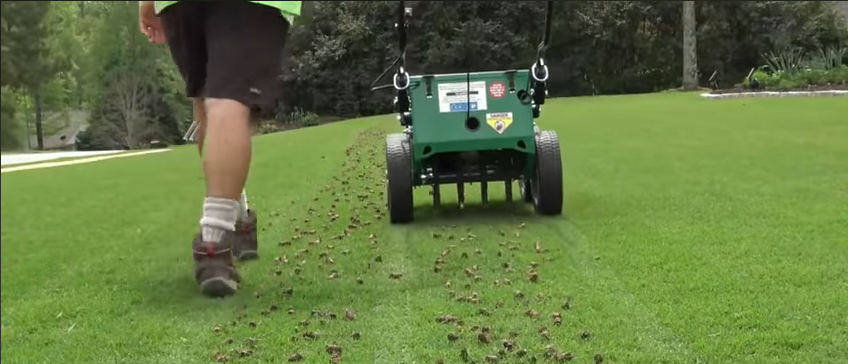The Benefits of Aeration: Perforating Your Soil for Healthier Lawns and Gardens
Aeration is the process of perforating the soil with small holes, allowing air, water, and nutrients to penetrate deep into the ground. This process has many benefits for lawns and gardens, and is an important part of maintaining healthy soil.
One of the main benefits of aeration is that it helps to alleviate soil compaction. Over time, soil can become compacted due to foot traffic, heavy machinery, or even just the weight of the soil itself. Compacted soil can make it difficult for water and nutrients to penetrate the ground, which can lead to unhealthy plants and poor soil quality.
By aerating your soil, you can help to break up the compaction and create more space for air and water to flow through the soil. This can improve the overall health of your plants, and also make it easier for them to take in the nutrients they need to grow strong and healthy.
Another benefit of aeration is that it can help to reduce thatch buildup in your lawn. Thatch is a layer of dead grass, leaves, and other organic material that accumulates on the surface of the soil. While a small amount of thatch can be beneficial for your lawn, too much can prevent water, air, and nutrients from reaching the roots of your grass.
By aerating your soil, you can help to break up the thatch layer and allow for better water and nutrient penetration. This can help to prevent the buildup of thatch over time, and keep your lawn healthy and vibrant.
Aeration can also help to improve soil drainage, which is important for preventing waterlogged soil and other issues. When soil becomes compacted, it can be difficult for water to flow through it, leading to standing water and other drainage problems.
By aerating your soil, you can help to create more space for water to flow through the soil, which can improve drainage and prevent issues like waterlogged soil. This can help to prevent root rot and other problems that can occur when plants are overwatered or when soil is unable to drain properly.
In addition to these benefits, aeration can also help to improve the overall health of your soil. When soil is healthy and nutrient-rich, it can support the growth of strong and healthy plants, which can in turn improve the overall look and feel of your lawn or garden.
So if you’re looking to improve the health and appearance of your lawn or garden, consider adding aeration to your regular maintenance routine. With just a little bit of effort, you can help to create a healthier and more vibrant outdoor space that you and your family can enjoy for years to come.
There are a few different methods of aeration that you can use, depending on your specific needs and the size of your lawn or garden. One of the most common methods is known as core aeration, which involves using a specialized tool to remove small plugs of soil from the ground.
This process can be done by hand, using a manual aerator tool, or by using a motorized machine that can cover larger areas more quickly. Whichever method you choose, be sure to follow the instructions carefully and take your time to ensure that the aeration is done properly.
It’s also important to note that aeration should be done at the right time of year for your specific type of grass or plants. In general, it’s best to aerate in the fall or spring, when the soil is moist and temperatures are mild.
If you’re not sure when to aerate your soil, consider consulting with a professional landscaper or garden expert. They can help you determine the best time to aerate your soil and provide guidance on the best methods for your specific needs.
Overall, there are many benefits to aeration, and it’s an important part of maintaining healthy soil for your lawn or garden. By taking the time to aerate your soil regularly, you can help to prevent soil compaction, reduce thatch buildup, improve drainage, and promote healthier, more vibrant plants.
In addition to aeration, there are other steps you can take to promote healthy soil in your lawn or garden. One important step is to ensure that your soil has the right balance of nutrients, including nitrogen, phosphorus, and potassium.
You can do this by adding fertilizer to your soil regularly, and by using compost or other organic materials to help improve soil quality. These materials can help to promote healthy microorganisms in the soil, which can help to break down organic matter and release nutrients for your plants to use.
Another important factor in maintaining healthy soil is proper watering. Overwatering can lead to waterlogged soil and other issues, while underwatering can cause plants to become stressed and die.
To ensure that your plants are getting the right amount of water, it’s important to water them deeply and infrequently, rather than giving them frequent shallow waterings. This can help to encourage deep root growth, which can help plants to access water and nutrients more easily.
In addition to these steps, it’s also important to monitor your soil regularly for signs of pests or diseases. If you notice any issues, it’s important to take action quickly to prevent the spread of these problems and protect the health of your plants.
By taking these steps to maintain healthy soil in your lawn or garden, you can create a vibrant and thriving outdoor space that you and your family can enjoy for years to come. And with regular aeration as part of your maintenance routine, you can help to ensure that your soil remains healthy and nutrient-rich, supporting the growth of strong and healthy plants for years to come.

